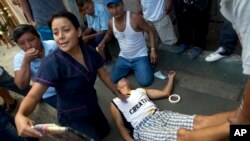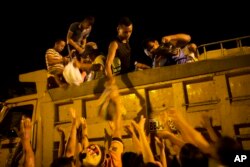In Ecuador, rescue teams continue to search for survivors in the rubble of Saturday's 7.8 magnitude earthquake, even as funerals begin for the more than 500 dead.
That number is likely to grow with some officials saying more than 1,700 people are still missing three days after the initial earthquake. "We have 2,000 people listed that are being looked for, but we have so far found 300," Deputy Interior Minister Diego Fuentes told reporters. However, Ecuador's defense ministry put the number of missing at 231.
According to government estimates, more than 4,600 people were injured.
Rescuers and citizens along the Pacific coast are using everything from heavy equipment and dogs to their bare hands to dig through the collapsed homes and stores, straining to listen for cries of help.
Successful rescues
A number of survivors have been pulled out of the rubble, but authorities say the cell phone calls and text messages from people buried under the wreckage are fading.
U.S. President Barack Obama telephoned President Rafael Correa Tuesday to convey the condolences of the American people for the earthquake deaths. He assured Correa the U.S. will do all it can to help Ecuador recover.
The U.S. Agency for International Development announced Tuesday that it will deploy two teams to the site — one to assist the government by assessing damage and needs, and a second to work with a U.N. team to coordinate international rescue activities. USAID has also pledged an initial contribution of $100,000 for critical supplies.
Ecuador’s government said it can access $600 million in emergency credit from multi-national lenders like the World Bank to finance its emergency response efforts, but Correa said the recovery could take more than two or three years and cost up to $3 billion.
"Let's not kid ourselves," Correa said after visiting the damage Tuesday. "It will be a long struggle... reconstruction for years, billions [of dollars] in investment."
Ecuador's economy is already in a severe recession because of dropping oil prices.
Fears of disease
Fears are also starting to emerge for those left homeless by the earthquake who are now easy targets for disease-carrying insects and have limited access to clean drinking water. According to UNICEF, around 150,000 children were affected by the disaster. And the Spanish Red Cross estimated that up to 100,000 people would need assistance.
About 1,500 buildings were damaged or destroyed by the earthquake and the resulting mud slides, the government said. It was the worst tremor in Ecuador since one in 1949 killed more than 5,000 people.
Saturday's quake was felt across the entire country, but the coastal cities of Portoviejo, Manta, and Pedernales were hit the hardest.










